theartsdesk in Bergen: Nattjazz, Nutshell review - Norway makes the case that musical genres are obsolete | reviews, news & interviews
theartsdesk in Bergen: Nattjazz, Nutshell review - Norway makes the case that musical genres are obsolete
theartsdesk in Bergen: Nattjazz, Nutshell review - Norway makes the case that musical genres are obsolete
Where jazz, folk, metal, vocal pop and impressionism occupy the same space

Superless are playing live for the first time. Instead of being bottom of a bill, this quartet have a prime spot at Bergen’s Nattjazz festival. Given the eminence of who’s in the band, it makes sense. Ingebrigt Håker Flaten (bass), Eirik Hegdal (woodwind) and Øyvind Skarbø (drums) are Norwegian and American guitarist Jeff Parker is based in Los Angeles.
All four have enviable track records. Amongst the signposts are Håker Flaten’s membership of The Thing, Hegdal’s involvement with the Trondheim Jazz Orchestra, Skarbø’s endless credits and Parker being in Tortoise. Whatever it is Superless are about to do, it will at least be notable.
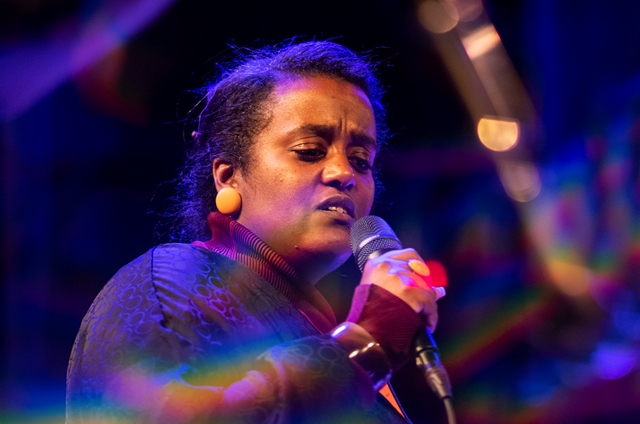 So it proves. There’s no sign that this is debut outing. Everyone gets to it with no fuss and what’s assertively performed isn’t abstracted or about free-form way-finding. There are solos but it’s all clipped and precise, with nods to Tortoise’s fondness for the metronomic. Skarbø’s drums and Håker Flaten’s bass are key. A snappy post-punk mind-set means that Superless evoke New York in a downtown early Eighties, post-no wave way – but without looking backwards. What’s been created sits apart from time and space. They begin recording their debut album the next day and based on this cool, smart show it will need hearing. (pictured right, Sofia Jernberg with The End, photo by Agnieszka Iwanska)
So it proves. There’s no sign that this is debut outing. Everyone gets to it with no fuss and what’s assertively performed isn’t abstracted or about free-form way-finding. There are solos but it’s all clipped and precise, with nods to Tortoise’s fondness for the metronomic. Skarbø’s drums and Håker Flaten’s bass are key. A snappy post-punk mind-set means that Superless evoke New York in a downtown early Eighties, post-no wave way – but without looking backwards. What’s been created sits apart from time and space. They begin recording their debut album the next day and based on this cool, smart show it will need hearing. (pictured right, Sofia Jernberg with The End, photo by Agnieszka Iwanska)
A day later, a band called The End are on the same stage. They feature another member of The Thing: sax man Mats Gustafsson. Perhaps Nattjazz might be about connections? And as any outfit with Gustafsson on board can sit within the free jazz/attitudinally post-punk Venn Diagram he’s created, musical associations are never far.
Fittingly, The End fluidly fuse disparate tactics. When guitarist Anders Hana plays what seems to be a mountain zither, sections of the pieces suggest Alice Coltrane at her most introspective. Then, suddenly, Gustafsson and fellow sax player Kjetil Møster start blowing and a storm arrives. Add in the extraordinary, alternately declamatory and devotional vocals of Sofia Jernberg and Børge Fjordheim's close-to metal drums, and it’s a pity when The End reach their end.
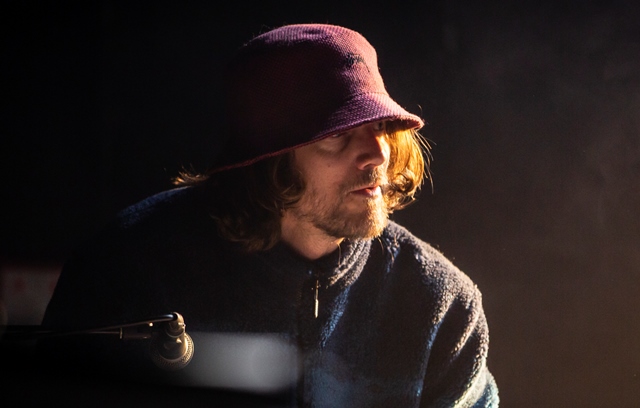 These two striking shows took place during the first two days of Nattjazz, a major jazz festival held in the USF Verftet, a former sardine factory which has been converted into an arts complex. USF stands for United Sardine Factory. This wasn’t all that was going on. In parallel, Nutshell is dedicated to raising the profile of Norwegian jazz in its most elastic sense. Dovetailing the two means it’s possible to dive into this aspect of Norway’s music while sniffing around the international visitors booked for Nattjazz. (pictured left, Gustav Ejstes with Amason, photo by Oddbjørn Steffensen)
These two striking shows took place during the first two days of Nattjazz, a major jazz festival held in the USF Verftet, a former sardine factory which has been converted into an arts complex. USF stands for United Sardine Factory. This wasn’t all that was going on. In parallel, Nutshell is dedicated to raising the profile of Norwegian jazz in its most elastic sense. Dovetailing the two means it’s possible to dive into this aspect of Norway’s music while sniffing around the international visitors booked for Nattjazz. (pictured left, Gustav Ejstes with Amason, photo by Oddbjørn Steffensen)
The mutability of what’s on offer is represented at USF by Swedish band Amason. At home, they’re big news and seemingly – judging by what they’ve issued – have little interest in looking beyond the Nordic world. One of their main drivers Gustav Ejstes has spent more time with Amason over the past decade than Dungen, the band he first came to attention in. Live, Amason intrigue. Amanda Bergman’s voice is blues based – a smoother Maggie Bell – but the music it weaves through is bedded by motorik drums and cloaked in the gauziness of Antiphon-era Midlake. Not so jazzy then.
In the Nutshell strand in a fish shed on the tiny 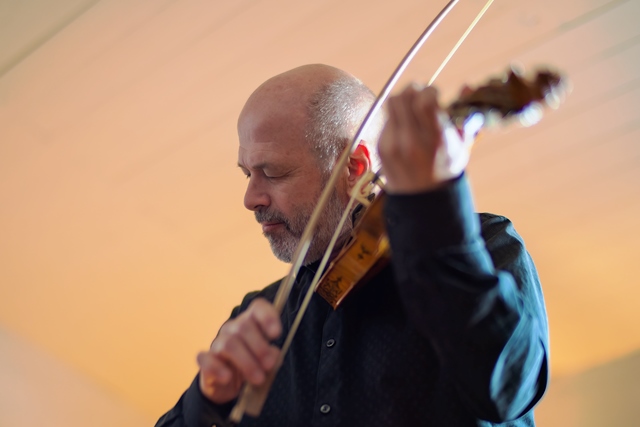 island of Oksen – an almost bare rock with salmon farming pens off its west side, beyond which there is nothing but water until the southern tip of Greenland – Hardanger fiddle player Nils Økland and harmonium player Sigbjørn Apeland are creating a music which is drone-based and meditative. The fiddle’s sympathetic strings and Apeland’s tendency to hold notes bolster the effect. The pair’s musical inquisitiveness has made them into – alone, in other collaborations and together – cornerstones of Norway’s exploratory music and here, at what was the limit of the known world, they express mystery and a deep knowledge of music as an emotional contemplation rather than as part of a spectacle A beautiful experience, drawing from folk and sacred music. Also not so jazzy. (pictured right, Nils Økland, photo by Jarle H. Moe)
island of Oksen – an almost bare rock with salmon farming pens off its west side, beyond which there is nothing but water until the southern tip of Greenland – Hardanger fiddle player Nils Økland and harmonium player Sigbjørn Apeland are creating a music which is drone-based and meditative. The fiddle’s sympathetic strings and Apeland’s tendency to hold notes bolster the effect. The pair’s musical inquisitiveness has made them into – alone, in other collaborations and together – cornerstones of Norway’s exploratory music and here, at what was the limit of the known world, they express mystery and a deep knowledge of music as an emotional contemplation rather than as part of a spectacle A beautiful experience, drawing from folk and sacred music. Also not so jazzy. (pictured right, Nils Økland, photo by Jarle H. Moe)
East of Bergen in the town of Øystese, Helga Myhr is playing her Hardanger fiddle outdoors on high ground overlooking the Hardangerfjord. Within her music is the pols (a speedier Norwegian variant on the polka) and the waltz. This isn’t jazz too, but it stresses the links in Norway between folk and jazz. Traditional themes were incorporated into Norwegian Jazz Fantasy, recorded by the Kristian Huger Jazzorkester in 1929; Bergen’s Edvard Grieg was already repurposing folk melodies in the 19th century. In 1964, at the Molde jazz festival, Dexter Gordon performed with folk musician Ivar Medaas. There was also a political aspect to tackling folk – it stressed Norwegian-ness, especially around the time of the 1972 referendum on whether to join the European Federation. In time, jazz musicians incorporated folk into their repertoire, Karin Krog, Svein Finnerud Trio and Jan Gaberek amongst them.
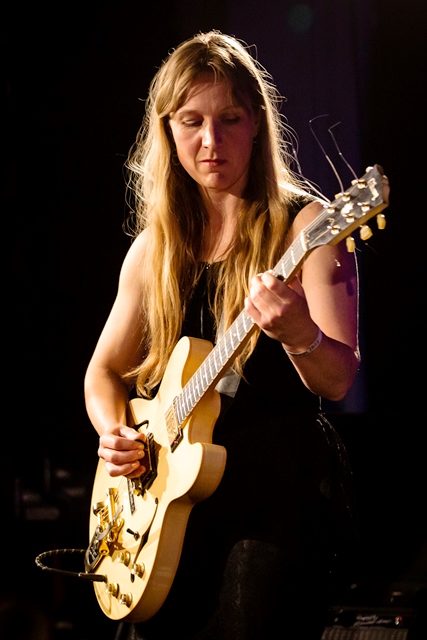 This persistent blurring of boundaries – or the failure to acknowledge them – surfaces forcefully at USF when Hedvig Mollestad reprises the recent Tempest Revisited album. Last year it received an award in the Spellemannprisen, the Norwegian analogue to the Brits. Although her music is entirely her own, she’s seen as a jazz composer/guitarist. Yet Tempest Revisited was in the Spellemannprisen’s open category rather than the jazz grouping. Even a supposed jazz musician is uncategorisable. Maybe foreseeable in this case as Tempest Revisited is a multi-faceted sound-picture of Ålesund, Mollestad’s birthplace. (pictured left, Hedvig Mollestad, photo by Oddbjørn Steffensen)
This persistent blurring of boundaries – or the failure to acknowledge them – surfaces forcefully at USF when Hedvig Mollestad reprises the recent Tempest Revisited album. Last year it received an award in the Spellemannprisen, the Norwegian analogue to the Brits. Although her music is entirely her own, she’s seen as a jazz composer/guitarist. Yet Tempest Revisited was in the Spellemannprisen’s open category rather than the jazz grouping. Even a supposed jazz musician is uncategorisable. Maybe foreseeable in this case as Tempest Revisited is a multi-faceted sound-picture of Ålesund, Mollestad’s birthplace. (pictured left, Hedvig Mollestad, photo by Oddbjørn Steffensen)
Nattjazz’s Tempest Revisited was more loose than when it was played in Oslo late last year and, consequently, there was space for unfettered playing as it wasn’t necessary to think so much about the music as it had become familiar. Such freedom brought a harder edge, especially evident in Ivar Loe Bjørnstad’s drums. This enormously impactful, thrilling performance was recorded by national broadcaster NRK for radio and it feels as if Tempest Revisited has now had a line drawn under it. Mollestad’s new album is scheduled for November and she constantly moves into new spaces so, as ever, whatever comes next won’t fail to delight.
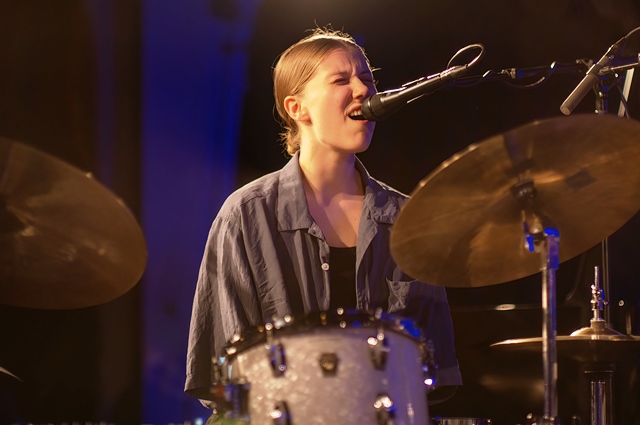 Drummer Veslemøy Narvesen has less of a profile than Mollestad. For Nutshell she was integral to the Mette Rasmussen Trio North but also performed her own musical suite We Don’t Imagine Anymore as the leader of a six-piece band. In this shape-shifting yet fully formed context Narvesen showcased a music which was as much jazz in the Mike Westbrook way as it was Sixties harmony-pop in the Free Design bag. Another strand boldly running throughout posited an awareness of jazz-inclined Seventies singer-songwriters such as John Martyn and Joni Mitchell. Audacious, and unlike anything else. Eyes needs keeping on Narvesen. (pictured right, Veslemøy Narvesen, photo by Jarle H. Moe)
Drummer Veslemøy Narvesen has less of a profile than Mollestad. For Nutshell she was integral to the Mette Rasmussen Trio North but also performed her own musical suite We Don’t Imagine Anymore as the leader of a six-piece band. In this shape-shifting yet fully formed context Narvesen showcased a music which was as much jazz in the Mike Westbrook way as it was Sixties harmony-pop in the Free Design bag. Another strand boldly running throughout posited an awareness of jazz-inclined Seventies singer-songwriters such as John Martyn and Joni Mitchell. Audacious, and unlike anything else. Eyes needs keeping on Narvesen. (pictured right, Veslemøy Narvesen, photo by Jarle H. Moe)
Another deft, genre-straddling combo are Voice & Strings & Timpani. Effectively, they are an expanded version of the trio Building Instrument where a second drummer, guitarist and vocalist have been added. It’s not so simple instrumentally as there’s a lot of doubling on electronics and keyboards, but that’s it in a nutshell. The Voice & Strings & Timpani concoction is free-ranging: Swingle Singers vocals, Popul Vuh and Pink Floyd’s Saucerful of Secrets pastoralism merge with a spacey amorphousness.
Amorphousness is equally applicable to the Natjazz-Nutshell experience. Not negatively but in relation to how genre is approached. Stylistic lines in the sand are absent. Superless and The End are jazz, but bring other sensibilities on board. After them, it’s less-and-less clear where anything sits. Jazz, folk, space-rock, Sixties vocal pop, pure impressionism – all are here. Connections are key, between the players and with their attitudes to making aesthetic intersections. Of course, as the Spellemannprisen did, the words “open category” could be used as a tag instead of jazz. But that might make selling tickets difficult.
The future of Arts Journalism
You can stop theartsdesk.com closing!
We urgently need financing to survive. Our fundraising drive has thus far raised £49,000 but we need to reach £100,000 or we will be forced to close. Please contribute here: https://gofund.me/c3f6033d
And if you can forward this information to anyone who might assist, we’d be grateful.

Subscribe to theartsdesk.com
Thank you for continuing to read our work on theartsdesk.com. For unlimited access to every article in its entirety, including our archive of more than 15,000 pieces, we're asking for £5 per month or £40 per year. We feel it's a very good deal, and hope you do too.
To take a subscription now simply click here.
And if you're looking for that extra gift for a friend or family member, why not treat them to a theartsdesk.com gift subscription?
more New music
 Album: Robert Plant - Saving Grace
Mellow delight from former Zep lead
Album: Robert Plant - Saving Grace
Mellow delight from former Zep lead
 Brìghde Chaimbeul, Round Chapel review - enchantment in East London
Inscrutable purveyor of experimental Celtic music summons creepiness and intensity
Brìghde Chaimbeul, Round Chapel review - enchantment in East London
Inscrutable purveyor of experimental Celtic music summons creepiness and intensity
 First Person: Musician ALA.NI on how thoughts of empire and reparation influenced a song
She usually sings about affairs of the heart - 'TIEF' is different, explains the star
First Person: Musician ALA.NI on how thoughts of empire and reparation influenced a song
She usually sings about affairs of the heart - 'TIEF' is different, explains the star
 Album: NewDad - Altar
The hard-gigging trio yearns for old Ireland – and blasts music biz exploitation
Album: NewDad - Altar
The hard-gigging trio yearns for old Ireland – and blasts music biz exploitation
 Album: The Divine Comedy - Rainy Sunday Afternoon
Neil Hannon takes stock, and the result will certainly keep his existing crowd happy
Album: The Divine Comedy - Rainy Sunday Afternoon
Neil Hannon takes stock, and the result will certainly keep his existing crowd happy
 Music Reissues Weekly: Robyn - Robyn 20th-Anniversary Edition
Landmark Swedish pop album hits shops one more time
Music Reissues Weekly: Robyn - Robyn 20th-Anniversary Edition
Landmark Swedish pop album hits shops one more time
 Album: Twenty One Pilots - Breach
Ohio mainstream superstar duo wrap up their 10 year narrative
Album: Twenty One Pilots - Breach
Ohio mainstream superstar duo wrap up their 10 year narrative
 Album: Ed Sheeran - Play
A mound of ear displeasure to add to the global superstar's already gigantic stockpile
Album: Ed Sheeran - Play
A mound of ear displeasure to add to the global superstar's already gigantic stockpile
 Album: Motion City Soundtrack - The Same Old Wasted Wonderful World
A solid return for the emo veterans
Album: Motion City Soundtrack - The Same Old Wasted Wonderful World
A solid return for the emo veterans
 Album: Baxter Dury - Allbarone
The don diversifies into disco
Album: Baxter Dury - Allbarone
The don diversifies into disco
 Album: Yasmine Hamdan - I Remember I Forget بنسى وبتذكر
Paris-based Lebanese electronica stylist reacts to current-day world affairs
Album: Yasmine Hamdan - I Remember I Forget بنسى وبتذكر
Paris-based Lebanese electronica stylist reacts to current-day world affairs
 theartsdesk on Vinyl 92: Marianne Faithful, Crayola Lectern, UK Subs, Black Lips, Stax, Dennis Bovell and more
The biggest, best record reviews in the known universe
theartsdesk on Vinyl 92: Marianne Faithful, Crayola Lectern, UK Subs, Black Lips, Stax, Dennis Bovell and more
The biggest, best record reviews in the known universe

Add comment